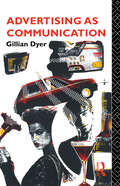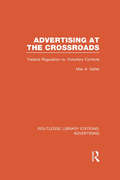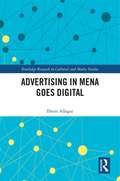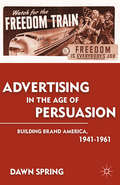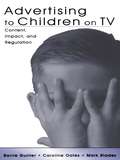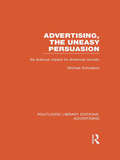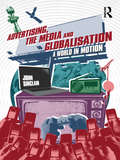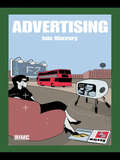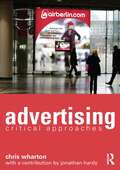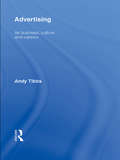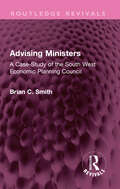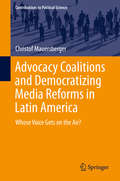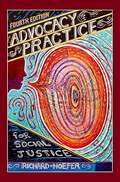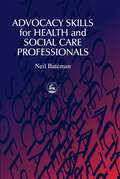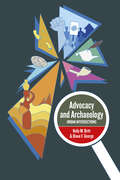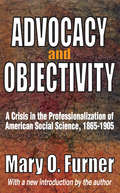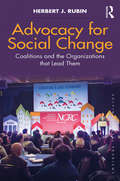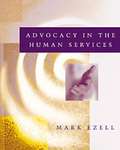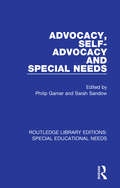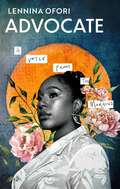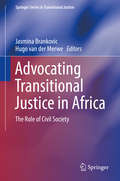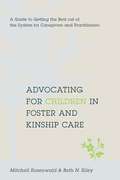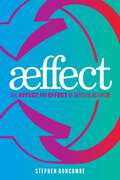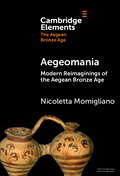- Table View
- List View
Advertising as Communication (Studies in Culture and Communication)
by Gillian DyerAdvertising is a form of communication that constantly impinges on our daily lives, yet we are often unaware of its more subtle form of persuasion, or of the extent to which it manipulates our (consumer) culture. This book sets out to examine advertising as a form of communication in contemporary society and also places it in its wider cultural and economic context.
Advertising at the Crossroads: Federal Regulation Vs. Voluntary Controls (Routledge Library Editions: Advertising)
by Max A. GellerAdvertising today is not only under sterner scrutiny by the various federal regulatory and judicial bodies but is also facing an ominous storm of public criticism because of certain abuses. One of the big questions troubling advertisers, agencies and media is whether advertising will be subject to increasingly stringent governmental controls or whether it will forestall such action by mature self-regulation. In Advertising at the Crossroads the author has attempted to face the issue squarely and realistically, and to point out several constructive measures that advertising must initiate in its self-interest. First published in 1952.
Advertising in MENA Goes Digital
by Ilhem AllaguiAn inside story of local, regional and global advertising in the Middle East. Grounded in empirical research and theories, this book explores the evolution of advertising practices, audiences, digital media and communication technologies in increasingly complex MENA environments. Advertising in MENA Goes Digital draws on empirical research and theories to explore how the adoption of digital technology in the Middle East and North Africa, through information and communication technologies, social media and mobile, have shaped creative advertising solutions. Through key case studies of marketing in the pan-Arab market from regional and global brands as Procter & Gamble, Olay, Vimto, and MTV Arabia, the book sheds light on the intricate relationship between technological and societal development and advertising practice. It examines cultural constituents such as humor, religion and gender, political advertising driven by the new wave of democracy in the region and digital activism, technological and digital transformations and the economic ways advertising support new media start-ups. Supported by examples and campaigns, the book discusses the way global or regional brands standardized or localized their messaging while adopting international techniques but market-oriented solutions. The book will key reading for scholars and students in advertising, marketing, business, journalism, cultural studies and media in addition to Middle East Studies. It is also an essential text for media and marketing communication industry professionals, and will appeal to those interested in the global-local dichotomy and promotional communications.
Advertising in the Age of Persuasion: Building Brand America 1941–1961
by D. SpringAdvertising in the Age of Persuasion documents and analyzes the implementation of the American strategy of consumerism during the 1940s and 1950s, and its ongoing ramifications. Beginning with World War II, and girded by the Cold War, American advertisers, brand name corporations, and representatives of the federal government institutionalized a system of consumer capitalism which they called free enterprise. In their system, government and business worked together to create consumer republics, democracies based on the mass consumption of brand name goods using advertising across all major media to sell products and distribute information. Many of the free enterprise evangelists believed it represented the fulfillment of America's god-ordained mission. They envisioned an American lead global consumer order supported by advertising based media where the brand took precedence over the corporation that owned it; and advertising, propaganda and public relations were considered the same thing. To support this system, they created a network and process for disseminating persuasive information that survives into the 21st Century.
Advertising to Children on TV: Content, Impact, and Regulation
by Barrie Gunter Caroline Oates Mark BladesConcern is growing about the effectiveness of television advertising regulation in the light of technological developments in the media. The current rapid growth of TV platforms in terrestrial, sattelite, and cable formats will soon move into digital transmission. These all offer opportunities for greater commercialization through advertising on media that have not previously been exploited. In democratic societies, there is a tension between freedom of speech rights and the harm that might be done to children through commercial messages. This book explores all of these issues and looks to the future in considering how effective codes of practice and regulation will develop.
Advertising, The Uneasy Persuasion: Its Dubious Impact on American Society (Routledge Library Editions: Advertising)
by Michael SchudsonWhat does advertising do? Is it the faith of a secular society? If so, why does it inspire so little devotion? Advertising, the Uneasy Persuasion is a clear-eyed account of advertising as both business and social institution. Instead of fuelling the moral indignation surrounding the industry, or feeding fantasies of powerful manipulators, Michael Schudson presents a clear assessment of advertising in its wider sociological and historical framework, persuasively concluding that advertising is not nearly as important, effective, or scientifically founded as either its advocates or its critics imagine. ‘Dispassionate, open-minded and balanced ... he conveys better than any other recent author a sense of advertising as its practitioners understand it.’ Stephen Fox, New York Times Book Review First published in 1984.
Advertising, the Media and Globalisation: A World in Motion
by John SinclairThis book offers a critical, empirically-grounded and contemporary account of how advertisers and agencies are dealing with a volatile mediascape throughout the world, taking a region-by-region approach. It provides a clear, systematic, and synoptic analysis of the dynamic relationship between media, advertisers, and agencies in the age of globalization, and in an era of transition from ‘mass’ to ‘social’ media. Advertising attracts much public criticism for the commercialization of culture and its apparent impact on social and personal life. This book outlines and assesses the issues involved, with regard to how they are manifested in different national, regional and global contexts. Topics covered include: advertising as an object of study global trends in the advertising industry advertising and the media in motion current issues in advertising, media and society advertising, globalization and world regions. While maintaining a contemporary focus, the book explains developments over recent decades as background to the globalisation of what it calls the manufacturing-marketing-media complex.
Advertising: Advertising Vol. Iv (Routledge Introductions To Media And Communications Ser.)
by Iain MacRuryAdvertising, once seen as 'the official art of capitalist society' is an increasingly commonplace component of a characteristically promotional culture. Iain MacRury's Advertising offers the means to explore and evaluate this transition with an introduction to advertising for the contemporary reader.Advertising provides a clear and easy guide to a
Advertising: Critical Approaches
by Chris WhartonAdvertising: Critical Approaches explores a broad range of critical theories and perspectives to shed new light on the organisation, workings and effects of the advertising industry today. Chris Wharton presents the social, cultural and economic role of advertising across history, with chapters tracking the process of advertising from production to reception. Split into three sections covering Foundations, Frameworks and Applications, the book’s chapters explore a range of areas central to an insight into the development of modern advertising, including: advertising history cultural, critical and political economy approaches to advertising texts in advertising the reception of advertising advertising in the home and outdoor advertising consumer culture. Case studies explore the diversity in the uses of advertising throughout history, from Ostia and the Square of the Corporations in the ancient Roman world to the UK Border Agency’s ‘Go Home’ campaign and contemporary City branding throughout Europe. Assessing the impact of the works of key critical thinkers including Marx, Morris, Lyotard, Barthes, Saussure, Williams and Hall have had on our understanding of consumption and advertising’s societal impact, Advertising: Critical Approaches illuminates and enhances our understanding and engagement with one of the most vital cultural and economic forces in contemporary society.
Advertising: Its Business, Culture and Careers
by Andy Tibbs‘A no-holds-barred overview of the very competitive but ultimately rewarding industry that is advertising. Insightful, well-informed, frank and honest. An inspirational eye-opener for all Adland wannabes’ – Gyles Lingwood, Course Leader, Creative Advertising, University of Lincoln, UK 'Like the advertising business, Tibbs' book is dynamic, edgy, and challenging. It captures the industry's excitement, energy, intellect, and creativity. The book is an inspiration and should be standard reading for all practitioners, students, and faculty of advertising, marketing, and communications'– Pamela Morris, Loyola University Chicago, USA ‘Tibbs’ insights turn the advertising agency from a mythical wonderland to a realistic career choice. Through reading this book and taking note of his advice, students will be one step closer to walking through its doors’ – Helen Powell, Senior Lecturer, Media and Advertising, University of East London, UK Advertising does not need another graduate! Whether you are an aspiring advertising creative, designer, account manager, PR / publicity consultant or marketing manager, Advertising is an engaging source of inspiration for those dark, idea-less days and a motivator when those job interviews or placements seem in short supply. Its Companion Website at: www.routledge.com/textbooks/advertising supports the book with further examples and ideas to inspire as well as offering up-to-date advice. This book is filled with numerous visual examples of advertising thinking. With words of advice and guidance from some of the industry’s most respected practitioners and insights from graduates who faced the same challenges you will soon encounter in securing that elusive first job. Add to that, an extensive supply of hints and tips to enhance the creative thinking processes, take the work you do beyond what you think you are capable of and, crucially, gain an edge at job interviews. Maybe advertising doesn’t need another graduate, but then you won’t be just another graduate will you?
Advising Ministers: A Case-Study of the South West Economic Planning Council (Routledge Revivals)
by Brian C SmithFirst published in 1969, Advising Ministers is a general account of the arrangements for ‘advising Ministers’, based on a case-study, enabling the reader to judge the effectiveness of an advisory body in a particular case, which itself gained much publicity and in which hopes were high that results would be achieved. Mr. Smith’s conclusions are based on published material and informed, shrewd deduction to provide a valuable addition to the all too meagre case-study material on British administration. This book will be of interest to students of history, sociology, economics and political science.
Advocacy Coalitions and Democratizing Media Reforms in Latin America: Whose Voice Gets on the Air? (Contributions to Political Science)
by Christof MauersbergerThis book examines democratizing media reforms in Latin America. The author explains why some countries have recently passed such reforms in the broadcasting sector, while others have not. By offering a civil society perspective, the author moves beyond conventional accounts that perceive media reforms primarily as a form of government repression to punish oppositional media. Instead, he highlights the pioneering role of civil society coalitions, which have managed to revitalize the debate on communication rights and translated them into specific regulatory outcomes such as the promotion of community radio stations. The book provides an in-depth, comparative analysis of media reform debates in Argentina and Brazil (analyzing Chile and Uruguay as complementary cases), supported by original qualitative research. As such, it advances our understanding of how shifting power relations and social forces are affecting policymaking in Latin America and beyond.
Advocacy Practice for Social Justice
by Richard HoeferSince the publication of its first edition in 2005, Advocacy Practice for Social Justice has served as a clear, comprehensive, and practical resource for social work courses in advocacy, community practice, and macro practice. Now in its fourth edition, this text provides extensive information on the value base for advocacy; an examination of why people get involved in advocacy; and step-by-step instructions for social workers and others who want to impact laws, regulations, and policies at any level. Bearing in mind the National Association of Social Workers' Code of Ethics' requirements to advocate on behalf of vulnerable populations, readers learn that advocacy is a problem-solving technique similar to that used in social work practice of all types. The book moves through the stages of advocacy: getting involved; understanding the issue; planning; advocating through education, persuasion, and negotiation; presenting information effectively; monitoring and evaluating results; and integrating advocacy into a social worker's everyday practice. The fourth edition's inclusion of new topics and solid foundation in social work values make it a must-read as social work students and practitioners work diligently to maintain the profession's focus on successful advocacy for social justice.
Advocacy Skills for Health and Social Care Professionals
by Neil BatemanMost professionals working in health or social care will be required to act as advocates as part of their work. A social worker or community nurse may need to obtain extra benefits or a particular service for a client; a housing official may need to help a tenant whose benefit has been delayed thus placing them at risk of homelessness; a voluntary body may decide to challenge a statement of special educational needs for a child. This is a practical guide to advocacy skills specifically written for those in the health and social care professions. Neil Bateman examines the function of advocacy within these professions and how to interview, negotiate and self-manage successfully. He provides a structure for advocacy, a guide to the ethical implications and advice on litigation and legal matters. Accessible and comprehensive, Advocacy Skills for Health and Social Care Professionals will be an essential resource for all those wishing to improve their practice.
Advocacy and Archaeology: Urban Intersections
by Kelly M. Britt and Diane F. GeorgeArchaeologists have a history of being prime agents of change, particularly in advocating for protection and preservation of historical resources. As more social issues intersect with archaeology and historical sites, we see archaeologists and others continuing to advocate for not only historic resources, but for the larger social justice issues that threaten the communities in which these resources reside. Inspired by the idea of revolution and excitement about the ways archaeology is being used in social justice arenas, this volume seeks to visualize archaeology as part of a movement by redefining what archaeology is and does for the greater good.
Advocacy and Objectivity: A Crisis in the Professionalization of American Social Science, 1865-1905
by Mary FurnerThis award-winning book of the Frederick Jackson Turner Studies describes the early development of social science professions in the United States. Furner traces the academic process in economics, sociology, and political science. She devotes considerable attention to economics in the 1880s, when first-generation professionals wrestled with the enormously difficult social questions associated with industrialization. Controversies among economists reflected an endemic tension in social science between the necessity of being recognized as objective scientists and an intense desire to advocate reforms.Molded by internal conflicts and external pressures, social science gradually changed. In the 1890s economics was defined more narrowly around market concerns. Both reformers and students of social dynamics gravitated to the emerging discipline of sociology, while political science professionalized around the important new field of public administration. This division of social science into specialized disciplines was especially significant as progressivism opened paths to power and influence for social science experts.Professionalization profoundly altered the role and contribution of social scientists in American life. Since the late nineteenth century, professionals have exerted increasing control over complex economic and social processes, often performing services that they themselves have helped to make essential. Furner here seeks to discover how emerging groups of American social scientists envisioned their role what rights and responsibilities they claimed how they hoped to perform a vital social function as they fulfilled their own ambitions, and what restraints they recognized.
Advocacy for Social Change: Coalitions and the Organizations That Lead Them (Solving Social Problems)
by Herbert J. RubinThis book portrays how small, geographically dispersed, and progressive social change and social service organizations working within a coalition can influence national-level social policies. Based on extensive empirical research on two national organizations and their local affiliates, one focusing on affordable housing and the other working to protect lower-income communities, this book shows the ways in which professionally staffed organizations that coordinate coalitions come about, and describes their work to mobilize coalition members to lobby and advocate, providing information, analysis and instruction to facilitate such action and, in so doing, becoming the public voice for the social change efforts of coalitions. Advocacy for Social Change details the characteristics of these organizations that the author has labeled as focal catalytic coalition organizations and then provides numerous examples of campaigns led by them on affordable housing and economic justice; campaigns that illustrate tactics that other social change organizations can emulate. As such, it will appeal to scholars of sociology with interests in social problems, social action, political sociology, urban studies, community development and organizing while extending the literature on interest group lobbying.
Advocacy in the Human Services
by Mark EzellThe object of this book is to educate students and professionals so that they have a deeper understanding of advocacy practice in order to serve clients fully.
Advocacy, Self-Advocacy and Special Needs (Routledge Library Editions: Special Educational Needs #25)
by Philip Garner Sarah SandowFirst published in 1995. This book concerns aspects of decision-making by, or on behalf of, children who have special educational needs. This is an area of concern, given that little attention had previously been given to the views of children on matters relating to their education. The book examines various themes relating to ‘advocacy’, in relation to classroom practice, school organisation and professional development in all phases of education. Additionally, the role of parents and of support agencies is considered. Each theme is developed by an author with expertise in that field, and the emphasis of the book is upon the practical considerations of implementing advocacy programmes in schools.
Advocate: A voice from the margins
by Lennina Ofori'Vital and illuminating . . . Advocate is a book that is equally generous and insightful, putting much of modern British narratives into sharp perspective . . . It's a gift' Jeffrey Boakye, author of Black, Listed and I Heard What You SaidLennina Ofori is a force of nature: a teen mother, a supportive older sister, a PhD candidate, a support system, a social entrepreneur, a survivor. Above all, she is an advocate. She has spent her life working for those relegated to the margins, and in this book, she lends her voice to them.Weaving in her own life story, from her beautiful family to her hardest struggles, Ofori opens the door to intersections that are familiar to many - race, class and gender - and uses her expertise to embolden readers to make active change in their own lives. Drawing on knowledge from across the globe, from the teachings of bell hooks to government reports, Ofori makes accessible topics that are so often ignored. From her unique perspective as a Black woman who has lived many lives, Ofori is a daring voice for change and hope in modern life.Advocate is a tale of personal resistance, but also a manifesto for action. With great candour, wit and beautiful language, Ofori will call you to make change not just for your own sake, but for those in the margins
Advocating Transitional Justice in Africa: The Role of Civil Society (Springer Series in Transitional Justice)
by Jasmina Brankovic Hugo van der MerweThis volume documents and analyses the strategies used by African civil society organisations to lobby for and enact transitional justice measures in their countries. The book offers local practitioners and African scholars space to reflect on the development and effectiveness of strategies in promoting transitional justice, as well as to identify the theoretical and contextual influences on transitional justice work. Most importantly, it presents lessons and best practices for advocating transitional justice. This edited volume fills a significant gap by providing an up-to-date regional African perspective on transitional justice in the form of a compilation of country-specific and thematic analyses of agenda-setting and lobbying efforts. It also offers insights into the state-civil society relationship on the continent. While including some historical perspective, the book chapters provide fresh and up-to-date insights into ongoing transitional justice efforts that are key to defining the future of how the field is understood in theory and in practice.
Advocating for Children in Foster and Kinship Care: A Guide to Getting the Best out of the System for Caregivers and Practitioners
by Mitchell Rosenwald Beth RileyThis book is the first to provide strategies for effective advocacy and placement within the foster care and kinship care systems. It also takes a rare look at the dynamics of the foster and kinship relationship, not just among children and the agency workers and service providers who intervene on their behalf, but also between children and those who take in and care for them as permanency develops. Drawing on their experience interacting with and writing about the institution of foster care, Mitchell Rosenwald and Beth N. Riley have composed a unique text that helps practitioners, foster parents, and relative caregivers realize successful transitions for youth, especially considering the traumas these children may suffer both before and after placement.Advocating for a child's best interests must begin early and remain consistent throughout assignment and adjustment. For practitioners, Rosenwald and Riley emphasize the best techniques for assessing a family's capabilities and for guiding families through the challenges of foster care. Part one details the steps potential foster parents and kinship caregivers must take, with the assistance of practitioners, to prepare themselves for placement. Part two describes tactics for successful advocacy within the court system, social service agencies, schools, and the medical and mental health establishments. Part three describes how to lobby for change at the agency and legislative levels, as well as within a given community. The authors illustrate recommendations through real-life scenarios and devote an entire chapter to brokering positive partnerships among practitioners, families, and other teams working to protect and transition children.
Aeffect: The Affect and Effect of Artistic Activism
by Stephen DuncombeThe first book to seriously identify how artistic activism works and how to make it work betterThe past decade has seen an explosion in the hybrid practice of “artistic activism,” as artists have turned toward activism to make their work more socially impactful and activists have adopted techniques and perspectives from the arts to make their interventions more creative. Yet questions haunt the practice: Does artistic activism work aesthetically? Does it work politically? And what does “working” even mean when one combines art and activism? In Æffect, author Stephen Duncombe sets out to address these questions at the heart of the field of artistic activism.Written by the co-founder and current Research Director of the internationally recognized Center for Artistic Activism, Æffect draws on Duncombe’s more than twenty-five years of experience in the field and one hundred in-depth interviews with artistic activists worldwide. More than a mere academic exercise, the theory, research, and tools in this book lay the groundwork for artistic activists to evaluate and strengthen their practice and to create better projects. The exploration of good artistic activism is grounded in three sets of concerns. 1) Change: Upon what theories of change is artistic activism based? 2) Intention: What do we hope and expect artistic activism to do, and how does it do this? 3) Evaluation: What actually happens as the result of an artistic activist intervention? Can it be measured?Æffect is rich with examples that demonstrate successful artistic activism, including Undocubus, an old bus painted “No Fear” across its side that was driven cross-country by a group of undocumented immigrant activists; Journal Rappé, a video show created by Senegalese rappers who created long-form investigative reports by rapping the current news in French and Wolof; and War on Smog, a staged a public performance piece by artistic activists in the city of Chongqing in Southwest China. Scannable QR codes are included to provide tools that help readers assess the æffect of their artistic activism.
Aegeomania: Modern Reimaginings of the Aegean Bronze Age (Elements in The Aegean Bronze Age)
by Nicoletta MomiglianoThis Element provides an overview of Aegeomania: the fascination, sometimes bordering on the obsession, with the Aegean Bronze Age, which manifests itself in the uses of Aegean Bronze Age material culture to create something new in literature, the visual and performing arts, and many other cultural practices. It discusses the role that Aegeomania can play in our understanding of the Aegean Bronze Age and illustrates this with examples from the 1870s to the present, which include, among many others, poems by Emma Lazarus, Salvatore Quasimodo, and Giorgos Seferis; novels by Kristmann Gudmundsson, Mary Renault, Don DeLillo, Zeruya Shalev, and Sally Rooney; Freudian psychoanalysis; sculptures by Henry Moore and Pablo Picasso; music by Harrison Birtwistle and the rock band Giant Squid; films by Robert Wise and Wolfang Petersen; elegant textiles and garments created by Josef Frank and Karl Lagerfeld. This title is also available as Open Access on Cambridge Core.
Aerial Aftermaths: Wartime from Above
by Caren KaplanFrom the first vistas provided by flight in balloons in the eighteenth century to the most recent sensing operations performed by military drones, the history of aerial imagery has marked the transformation of how people perceived their world, better understood their past, and imagined their future. In Aerial Aftermaths Caren Kaplan traces this cultural history, showing how aerial views operate as a form of world-making tied to the times and places of war. Kaplan’s investigation of the aerial arts of war—painting, photography, and digital imaging—range from England's surveys of Scotland following the defeat of the 1746 Jacobite rebellion and early twentieth-century photographic mapping of Iraq to images taken in the immediate aftermath of 9/11. Throughout, Kaplan foregrounds aerial imagery's importance to modern visual culture and its ability to enforce colonial power, demonstrating both the destructive force and the potential for political connection that come with viewing from above.
